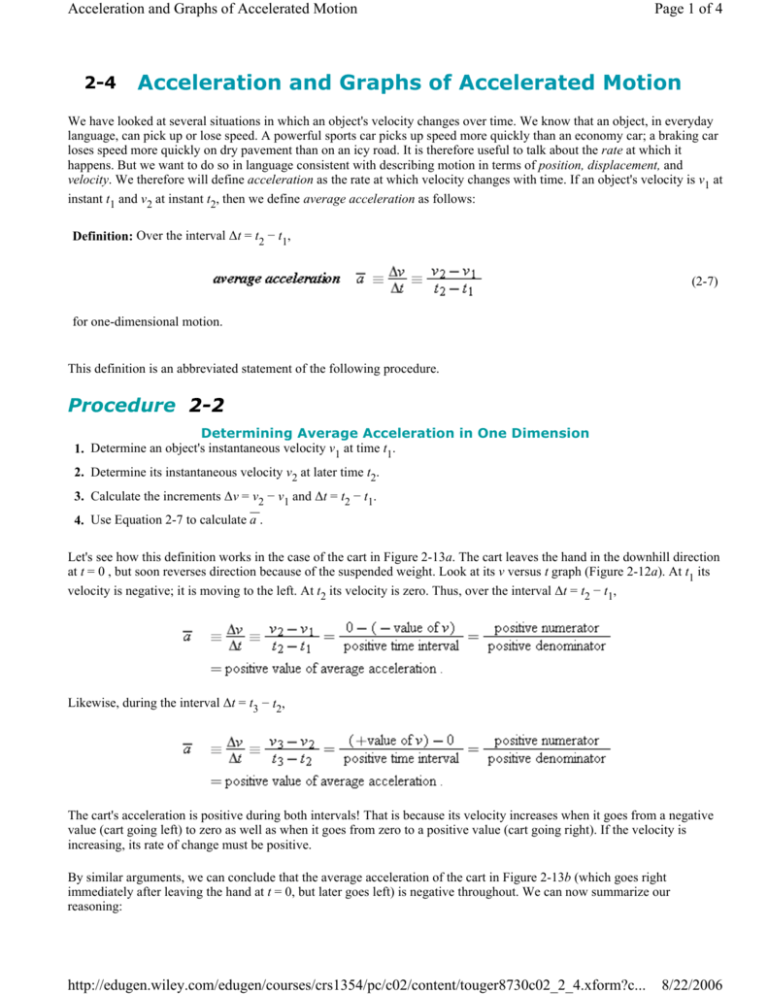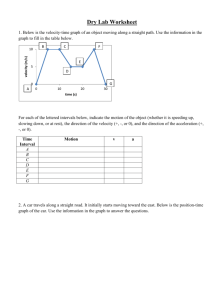
Acceleration and Graphs of Accelerated Motion
2-4
Page 1 of 4
Acceleration and Graphs of Accelerated Motion
We have looked at several situations in which an object's velocity changes over time. We know that an object, in everyday
language, can pick up or lose speed. A powerful sports car picks up speed more quickly than an economy car; a braking car
loses speed more quickly on dry pavement than on an icy road. It is therefore useful to talk about the rate at which it
happens. But we want to do so in language consistent with describing motion in terms of position, displacement, and
velocity. We therefore will define acceleration as the rate at which velocity changes with time. If an object's velocity is v1 at
instant t1 and v2 at instant t2, then we define average acceleration as follows:
Definition: Over the interval ∆t = t2 − t1,
(2-7)
for one-dimensional motion.
This definition is an abbreviated statement of the following procedure.
Procedure 2-2
Determining Average Acceleration in One Dimension
1. Determine an object's instantaneous velocity v1 at time t1.
2. Determine its instantaneous velocity v2 at later time t2.
3. Calculate the increments ∆v = v2 − v1 and ∆t = t2 − t1.
4. Use Equation 2-7 to calculate a .
Let's see how this definition works in the case of the cart in Figure 2-13a. The cart leaves the hand in the downhill direction
at t = 0 , but soon reverses direction because of the suspended weight. Look at its v versus t graph (Figure 2-12a). At t1 its
velocity is negative; it is moving to the left. At t2 its velocity is zero. Thus, over the interval ∆t = t2 − t1,
Likewise, during the interval ∆t = t3 − t2,
The cart's acceleration is positive during both intervals! That is because its velocity increases when it goes from a negative
value (cart going left) to zero as well as when it goes from zero to a positive value (cart going right). If the velocity is
increasing, its rate of change must be positive.
By similar arguments, we can conclude that the average acceleration of the cart in Figure 2-13b (which goes right
immediately after leaving the hand at t = 0, but later goes left) is negative throughout. We can now summarize our
reasoning:
http://edugen.wiley.com/edugen/courses/crs1354/pc/c02/content/touger8730c02_2_4.xform?c...
8/22/2006
Acceleration and Graphs of Accelerated Motion
Time Interval
∆t
Cart in Figure 213a
Page 2 of 4
Change in Velocity ∆v
What Object Is Doing
t2 − t1 = +value
+
t3 − t2 = +value
+
Cart in Figure 213b
t2 − t1 = +value
−
Moving left but slowing
down
Moving right and speeding
up
Moving right but slowing
down
Moving left and speeding up
t3 − t2 = +value
−
Units of Average Acceleration Average acceleration is the rate of change of velocity. For instance, if a
car went from 0 to 60 mi/hr in 5 seconds, it would be gaining an average of 12 mi/hr each second, or per second. Its
acceleration in mixed units would be 12 (mi/hr)/s In SI, the units of average acceleration are m/s (meters per second)
divided by s, giving us (m/s)/s (meters per second per second). If, for example, your velocity changes from 15 m/s to 35 m/s
as your stopwatch advances from 3 s to 7 s, your velocity increases on the average by 5 m/s during each second of the 4-s
time interval. Then
Note that mathematically, (m/s)/s means
so you will also see (m/s)/s written as m/s2 (meters per second squared) or as ms−2. No matter—it still means the same
thing.
Average Acceleration as Slope of v Versus t Graph If we apply the general definition of slope
to v versus t plots such as those in Figure 2-12, we find that the slope is
. But
is our definition of average
acceleration.
The slope of a v versus t graph between t1 and t2 is equal to the average acceleration over that interval.
If the graph is not a straight line between t1 and t2, then the slope is understood to mean the slope of the secant connecting
http://edugen.wiley.com/edugen/courses/crs1354/pc/c02/content/touger8730c02_2_4.xform?c...
8/22/2006
Acceleration and Graphs of Accelerated Motion
Page 3 of 4
(t1, v1) and (t2, v2).
The graph in Figure 2-12a rises left to right—its slope is always positive. The descending graph in Figure 2-12b always has
a negative slope. But the slope is the average acceleration. So as we concluded previously, the acceleration is always
positive for the motion graphed in Figure 2-12a and always negative for the motion graphed in Figure 2-12b.
Instantaneous Acceleration Like average velocity, average acceleration is defined over an interval. As we
did for average velocity in WebLink 2-1, we can find average accelerations for progressively smaller time intervals. The
value approached as the interval closes in on a particular instant is defined to be the acceleration at that instant.
Definition: In one dimension,
(2-8)
Without a bar, a denotes instantaneous acceleration.
When the v versus t graph is not a straight line, we can “zoom in” on a segment that includes any instant t that interests us.
If we zoom in close enough, the segment is essentially straight, and its slope gives the instantaneous acceleration at that
instant.
Example 2-5 Determining Instantaneous Accelerations by Finding Slopes
The motion of a certain object is represented by the v versus t graph in Figure 2-14. Find approximate values of the
instantaneous acceleration
a. at t = 2.0 s
b. at t = 20.0 s
Figure 2-14 Graph of v versus t for Example 2-5.
Solution
Choice of approach. Pick a small segment of the graph that includes each instant, then find the slope of each segment.
The mathematical solution.
http://edugen.wiley.com/edugen/courses/crs1354/pc/c02/content/touger8730c02_2_4.xform?c...
8/22/2006
Acceleration and Graphs of Accelerated Motion
Page 4 of 4
a. To include t = 2.0 s, we arbitrarily pick the interval from t1 = 1.5 s to t2 = 2.5 s. (You can redo this choosing an even
smaller interval to see how much it changes your result—see Problem 2-100 at the end of the chapter.) From the
graph, we find that the velocity at t1 = 1.5 s has the value v1 = 10.2 m/s, and at t2 = 2.5 s, its value is v2 = 15.6 m/s.
The slope of the chosen segment is
Then at t = 2.0 s, the instantaneous acceleration a ≈ 5.4 (m/s)/s or 5.4 m/s2 .
b. As we go beyond t = 10 s, we see the graph becoming more nearly horizontal. Because the slope of any horizontal line
is zero, the slope of a small enough segment including t = 20.0 s is approximately zero, and so a ≈ 0.
Making sense of the results. The value obtained in b reflects the fact that by t = 20 s, the velocity is no longer changing.
Related homework: Problems 2-28, 2-29, and 2-100.
Copyright © 2004 by John Wiley & Sons, Inc. or related companies. All rights reserved.
http://edugen.wiley.com/edugen/courses/crs1354/pc/c02/content/touger8730c02_2_4.xform?c...
8/22/2006








